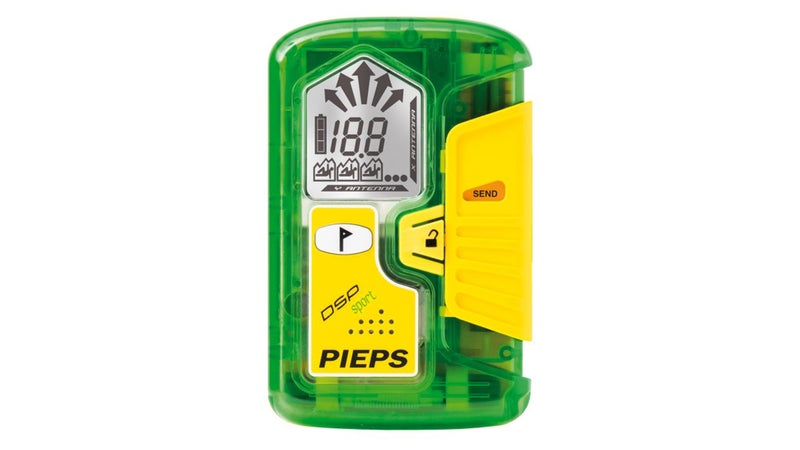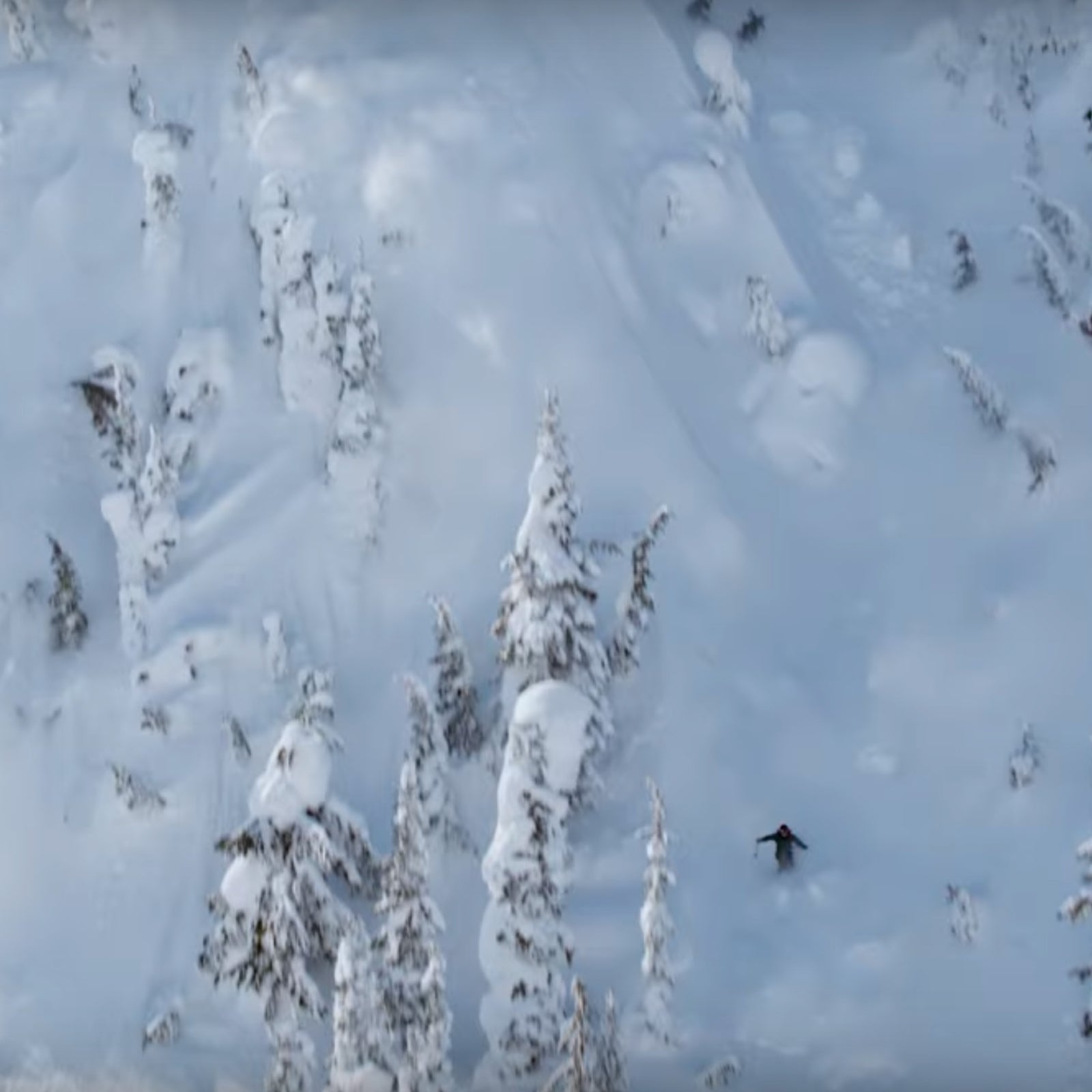For four skiers and the crew filming them near Whistler, British Columbia, things were going as planned. It was sunny and blue on March 9, 2020, and the team was descending ambitious lines in stable snow as Teton Gravity Research cameras pointed at them for the new film, Make Believe. They’d performed a check of their avalanche safety beacons that morning, as they’d done hundreds of times in the past. Before calling it a day, eyed a line with a series of pillowy drops. It looked clear of overhead hazards. McNutt took a lap, then skinned up to log another clip. Across the valley, guide and fellow athlete Christina “Lusti” Lustenberger watched in awe as he linked turns on the line for the second time. But off to the side, his slough from the top loosened a giant pillow of snow. As he exited the gully, he collided with the debris and was swept sideways into some trees and beneath the snow’s surface.
On snowmobiles, the group quickly sped to where McNutt had disappeared and switched their beacons to search mode. For a team this experienced, this should have identified his proximate location relatively quickly. But something was wrong—they couldn’t find a signal. If too many minutes passed, McNutt would run out of air. The group started probing through the surface the snow in the area where they had seen him go under. In a stroke of luck, a cinematographer struck McNutt within a few jabs. Working fast, the team shoveled nearly four feet of snow off their friend, who was coughing up blood and had a broken arm. They loaded him onto a snowmobile, kept him warm with extra jackets, and waited more than an hour for search and rescue to airlift him to the hospital, where he was quickly stabilized and monitored for four days. The question on everyone’s mind was, had his beacon—a Pieps DSP Pro that was a few seasons old—switched off in its harness around his chest without him knowing?
The team concluded that there was a serious problem with McNutt’s device, even though it had no visible damage. Transceivers have two settings: send and search. When you’re skiing, you lock it in send mode. When someone is buried in a slide, everyone else switches to search to pick up their companion’s signal beneath the snow. It’s standard protocol for everyone to check and make sure their beacons are in the correct mode before a group starts skiing in the backcountry (it’s obvious when someone’s beacon is in search instead of send because the device starts chirping). They believe McNutt’s had moved between modes even though it was supposed to be locked.
In the seven months since the incident, the team worked with Pieps and sister brand Black Diamond (which distributes Pieps beacons) to run a series of tests and investigate whether beacons turning off without the user knowing was a recurring problem on the DSP Pro and models. During the same period, the athletes learned through conversations with friends and guides that other people had noticed anomalies with the same models. Most stories came from users who finished a safe day of skiing and discovered that their beacons had switched modes. Seeing the potential for more accidents, they urged the brand to issue a global recall. “The only time that I’ve ever needed it to work for real, it didn’t,” McNutt says. “It’s concerning.”
By early October, Pieps and Black Diamond had yet to make a public statement with any findings or plans to address the alleged issues, though both companies did launch trade-in programs, in which by emailing dsp@pieps.com. With winter looming and this year’s backcountry participation expected to surge in light of the pandemic, the athletes felt a responsibility to alert the larger community to the potential issues with the beacons. On October 10, Lustenberger published a about their experience last spring. In response, a flood of other users shared on social media and forums about similar experiences with the same models switching modes while in the field. Lustenberger has screenshotted more than 40 comments on her public Instagram account from people with comparable problems. “Mine turned itself off in my pocket numerous times!” wrote one person. The community’s main allegation is that the switch can move between modes unknowingly, due to its placement on the face of the beacon, where it can be partially depressed in its harness. They also think the lock button degrades over time and use.
Among those who took notice was Brianne Howard, who lost her husband, Corey Lynam, in an avalanche in March 2017. Lynam wore a Pieps DSP Sport beacon in his front jacket pocket during a backcountry outing in Whistler’s Callaghan Valley. He was buried for four hours because rescuers couldn’t acquire a signal. According to an investigation by the Royal Canadian Mounted Police, his beacon was in search mode instead of send mode, despite performing safety checks. Black Diamond says that as soon as Pieps was made aware of Lynam’s accident, they contacted the search and rescue team and local authorities to learn more about what happened. Howard hired a lawyer to craft a letter to brand leadership in December 2017 asking them to investigate and recall the product. Black Diamond says it sent a reply on January 2, 2018. TÜV SÜD, a third party test lab in Europe, inspected Lynman’s transceiver and found it to be operational; Black Diamond never directly inspected it because it was part of the police investigation. She decided to speak up publicly when McNutt and his friends began sharing a few weeks ago.
Meanwhile, on October 16, a against the brands in the Supreme Court of British Columbia. The lawsuit alleges negligence of design on several different devices including the DSP Sport and Pro models, “where the transceivers involved allegedly turned into ‘Off’ or ‘Search’ mode while being carried.” Black Diamond and Pieps declined to comment on the lawsuit. Howard and the athletes say they’re not involved. “None of us are trying to slander Pieps or Black Diamond,” skier Ian McIntosh says in a . “That is not our motivation. Our motivation is simply the safety of all backcountry travelers.”
Last week, Black Diamond confirmed that they had temporarily removed the Sport—the brand’s entry-level version at $299—from Black Diamond’s website. The Pro was phased out in 2017 and the following year, Pieps released four new models with Bluetooth technology and a different locking mechanism. Instead of pushing a button to unlock and lock the device, you have to push and slide the lock in order to move between modes. The athletes say they haven’t heard of Pieps’ other models having any problems.

However, Pieps and Black Diamond told �����ԹϺ��� that while they understand the concern, and acknowledge that “no beacon is perfect,”��the devices are safe and exceed certification standards after rigorous internal and third-party testing and investigation. Whenever they receive a claim that a product is defective, they first try to get the customer’s device back for inspection in the lab. “In my line of work, we can’t afford to assume anything,” says Rick Vance, vice president of quality at Black Diamond and Pieps. McNutt’s beacon from the accident was lost in the mail, but Pieps tested the switch strength of his friends’ models, including one with a damaged lock button, and other used beacons of similar age (three to five years).
Their goal in this mechanical test was to rule out an aging affect. Pieps and Black Diamond claim the tests accomplished this. They did confirm, however, that the lock’s��function reduces by 50 to 100 percent when the button is cracked or weakened some other way. In measuring the beacon design’s efficacy, they compared new and used DSP Sport and Pro to other brands on the market. “That study concluded that we are in the range of what’s on the market right now,” Vance says. “That tells us two things: We don’t have a manufacturing batch-level issue where we could launch a recall that says, ‘If your serial numbers are between X and Y, return your beacon.’ And we don’t have an issue compared to the state of the art.” Therefore, Vance says, the alleged issues don’t meet the requirements for a recall. According to a company spokesperson, 150,000 DSP Sport and Pro models have been sold globally.
to their 5,000 Instagram followers a few days after Lustenberger first shared her crew’s experience. On the last slide, Vance demonstrates where to inspect the beacon for cracks and how to properly slide between modes by depressing the small lock button. He also shows how to override the locking mechanism by pushing it. “Never force the slider between positions without depressing the lock button,” he says. “This damages the locking mechanism and if you’ve done so, retire immediately.”
But the skiers stand firm that the beacon switching between modes isn’t always a user error. And a working transceiver is a vital piece of the avalanche life-saving kit along with a probe and shovel. Avalanche Canada Forecasting program supervisor Jim Floyer says, “It’s absolutely critical that we maintain trust in the transceiver system.”
Pieps and Black Diamond told �����ԹϺ��� that their top priority is safety and they’re working hard to win back the trust of the community. The situation has also led to conversations about updating beacon certifications and standards, Vance says.
McNutt and his friends say that the brands’ actions are steps in the right direction. But without a full recall of the two products, they’re afraid that the warning won’t reach every single customer. They say they’ll continue communicating with as many people as they can. To them, the devices passing tests in the labs is irrelevant—they need them to work in the field. “I just don’t want to see people using this device,” Lustenberger says. “I don’t want people to be playing Russian roulette with their safety gear and hoping that it will stay in the desired mode during an accident.”��
��


